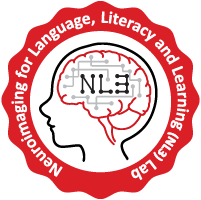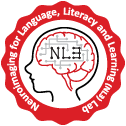| Yingying Wang, Ph.D. Associate Professor Department of Special Education and Communication Disorders (SECD) College of Education and Human Science (CEHS) Principal Investigator, Neuroimaging for Language, Literacy and Learning (NL3) Laboratory Resident Faculty, Center for Brain, Biology and Behavior (CB3) Affiliated with Nebraska Center For Research on Children, Youth, Families and Schools (CYFS) University of Nebraska–Lincoln (UNL) Email: yingying.wang@unl.edu Phone: +1-402-472-0106 |
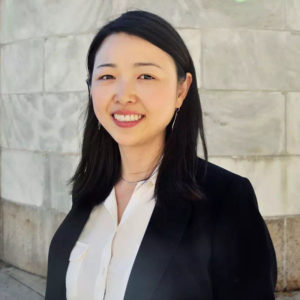 |
||||||
|
|
 I was born and raised in Shanghai, China (a financial center in China like New York City in the United States, on the east coast of China). After obtaining both B.S. and M.S. in Biomedical Engineering/Medical Imaging from Shanghai University (Shanghai, China), I joined a research lab led by Dr. Jing Xiang to learn about the Magnetoencephalography (MEG) technique at SickKids Hospital (Toronto, Canada) in November 2005. The research lab was recruited by Cincinnati Children’s Hospital (Cincinnati, OH), and I moved there to work as a research assistant in June 2006. This transition rekindled my childhood dream of becoming a scientist. I was involved with many MEG research studies, and my interest in various types of complex brain imaging data changed the course of my career. Fascinated by delta (< 4 Hz), theta (4 – 8 Hz), and alpha (8 – 12 Hz), beta (13 – 30 Hz), gamma (> 30 Hz) bands of brain rhythms, I took a graduate-level imaging signal processing course taught by Dr. Douglas Mast at the University of Cincinnati during the winter quarter of 2008.
I was born and raised in Shanghai, China (a financial center in China like New York City in the United States, on the east coast of China). After obtaining both B.S. and M.S. in Biomedical Engineering/Medical Imaging from Shanghai University (Shanghai, China), I joined a research lab led by Dr. Jing Xiang to learn about the Magnetoencephalography (MEG) technique at SickKids Hospital (Toronto, Canada) in November 2005. The research lab was recruited by Cincinnati Children’s Hospital (Cincinnati, OH), and I moved there to work as a research assistant in June 2006. This transition rekindled my childhood dream of becoming a scientist. I was involved with many MEG research studies, and my interest in various types of complex brain imaging data changed the course of my career. Fascinated by delta (< 4 Hz), theta (4 – 8 Hz), and alpha (8 – 12 Hz), beta (13 – 30 Hz), gamma (> 30 Hz) bands of brain rhythms, I took a graduate-level imaging signal processing course taught by Dr. Douglas Mast at the University of Cincinnati during the winter quarter of 2008.
That was my introduction to the fascinating field of brain imaging. About one year later I started my graduate program in Biomedical Engineering/Medical Imaging at the University of Cincinnati under Dr. Scott K. Holland, and graduated with a Ph.D. in December 2013. From Scott, I learned the foundational knowledge of many neuroimaging techniques, including MEG, functional magnetic resonance imaging (fMRI), diffusion-weighted imaging (DWI), and how to use them to study the developmental changes of children’s language development. During the same period, Scott was building two centers at Cincinnati Children’s Hospital: Communication Sciences Research Center and Reading & Literacy Discovery Center. He greatly influenced me and sparked my interest in studying neurobiological bases of reading and hearing.
I took a postdoc fellow position to learn about the neurobiological bases of reading in Dr. Nadine Gaab’s lab at Boston Children’s Hospital/Harvard Medical School in January 2014. Nadine’s research within the Laboratories of Cognitive Neuroscience focuses on the brain correlates of reading development in typical and atypical children as well as possible pre-markers of developmental dyslexia in preschoolers and infants. She uses functional magnetic resonance imaging (fMRI), a non-invasive brain imaging tool, as well as behavioral measurement tools to study the reading brain. I cherish my two-year postdoctoral training experience in Dr. Gaab’s lab, where I learned the Automating Fiber-Tract Quantification (AFQ) method and analyzed hundreds of fMRI and behavioral data of children with a family history of developmental dyslexia and control group.
In January 2016, I became an assistant professor in the Department of Special Education and Communication Disorders (SECD) at the University of Nebraska-Lincoln (UNL). My lab examines brain plasticity due to sensory loss and to study brain development during literacy and language acquisition using advanced brain imaging techniques (e.g., fMRI, DWI, fNIRS, MEG) and behavioral assessments. My ongoing projects include identification of brain factors that predict speech perception outcomes for cochlear implant candidates and examination of the neural basis of reading in children who are deaf/hard of hearing. I am committed to interdisciplinary research and collaboration to bridge brain, behavior, and clinical sciences. I also encourage students to develop critical thinking skills and become involved in research early.
Ph.D., Biomedical Engineering/Medical Imaging, 2009 – 2013.
Department of Biomedical Engineering, University of Cincinnati, OH, United States.
Dissertation: “Integration of fMRI and MEG towards modeling language networks in the brain,” Advisor: Dr. Scott K. Holland
M.S., Biomedical Engineering/Medical Imaging, 2002 – 2005.
Department of Biomedical Engineering, Shanghai University, Shanghai, China.
Thesis: “Three-dimensional reconstruction technique of image from digital subtraction angiography (DSA),” Advisor: Dr. Weicheng Zhang
B.S., Biomedical Engineering/Medical Imaging, 1998 – 2002.
Department of Biomedical Engineering, Shanghai University, Shanghai, China.
Thesis: “Collection, conversation and net transport of medical signal,” Advisor: Dr. Weicheng Zhang
Associate Professor (tenured), 2022 – Present.
Department of Special Education and Communication Disorders, University of Nebraska – Lincoln, NE, United States.
My Roles: As the PI, I continue to seek external support for my cochlear implant project. Meanwhile, my team started to collect parent-child interaction data and is aiming to identify brain correlates that explain individual differences in emotional processing in children with autism and children who are typically developing. Despite the interest in reading development in children who are deaf/hard of hearing, we had to postpone this project due to a lack of funding support and difficulties in recruitment.
Assistant Professor (tenure track), 2016 – 2022.
Department of Special Education and Communication Disorders, University of Nebraska – Lincoln, NE, United States.
My Roles: Building an independent research laboratory; My team currently focuses on identifying brain factors that predict speech perception outcomes for cochlear implant candidates and determining the brain basis of reading development in children who are deaf/hard of hearing.
Post-doc Research Fellow, 2014 – 2015.
Division of Developmental Medicine, Boston Children’s Hospital/Harvard Medical School, MA, United States, Mentor: Nadine Gaab, Ph.D.
My Roles: Built data processing pipeline in MATLAB to analyze functional magnetic resonance imaging (fMRI) and diffusion-weighted imaging (DWI) data to identify the neural basis of developmental dyslexia for early identification of children at risk for dyslexia.
Graduate Research Assistant, 2009 – 2013.
Department of Radiology, Cincinnati Children’s Hospital/University of Cincinnati, OH, United States, Mentor: Scott K. Holland, Ph.D.
My Roles: Developed MATLAB tools to combine fMRI and Magnetoencephalography (MEG) data in order to study language function and networks in the brain.
Research Assistant III, 2006 – 2009.
Division of Neurology, Cincinnati Children’s Hospital, OH, United States, Supervisor: Jing Xiang, M.D., Ph.D.
My Roles: Recruited over 150 children to participate in a MEG study, aiming to study visual, auditory, sensory-motor and language functions in children age range from 6 to 17; Assisted clinical doctors with their research design and data collection; Trained many undergraduate students and visiting scholars on how to collect and analyze MEG data.
Research Assistant, 2005 – 2006.
Department of Diagnostic Imaging, SickKids Hospital, ON, Canada, Supervisor: Jing Xiang, M.D., Ph.D.
My Roles: Developed MEG signal processing toolbox.
Graduate Research Assistant, 2002 – 2005.
Department of Biomedical Engineering, Shanghai University, Shanghai, China, Advisor: Weicheng Zhang, Ph.D.
My Roles: Developed a software package that connects two computers through the series interface; Developed a MATLAB program to simulate digital subtraction angiography (DSA) signals.
| Research Development Fellows Program, Office of Research and Economic Development, University of Nebraska–Lincoln (course release, fellowship) | 10/2018 |
|---|---|
| Scholarly Enhancement Program, College of Education and Human Sciences, University of Nebraska–Lincoln (course release, fellowship: $1,700) | 08/2016 |
| The Fellow Award, Division of Developmental Medicine, Boston (1/30) | 12/2015 |
| Cognitive Neuroscience Society (CNS), People’s Choice Award, Boston (1/300) | 04/2014 |
| NIH funded Neuroimaging Training Award, University of California | 06/2014 |
| Graduate Student Research Fellowship, University of Cincinnati (top 27%) | 06/2012 |
| Conference Travel Awards, University of Cincinnati (top 20%) | 2012, 2013 |
| Shanghai Outstanding Graduate Student Award (top 5%) | 2005 |
| Special Grade Scholarship, Shanghai University, China (top 5%) | 1998, 1999 |
| First Grade Scholarship, Shanghai University, China (top 5%) | 1999 – 2001 |
| Merit Student, Shanghai University, China (top 5%) | 1998 – 2005 |
Research Interests
After joining UNL, it took me a while to identify and establish my own research focuses. Generally speaking, I am interested in neural plasticity and brain development, especially due to learning (reading, language, and new skills, etc.) over time. I was inspired by the literature review on Cochlear Implant (CI) I completed in 2010 with my advisor Scott and my first experience of observing a surgical procedure for implanting a CI device on a young child at Cincinnati Children’s Hospital. I decide to make some contributions to use neuroimaging approaches to understand the neural plasticity after the CI implantation and auditory rehabilitation afterward. I am also interested in continuing my postdoctoral work to understand the neurobiological bases of reading in a different population. Since my home Department of Special Education and Communication Disorders has a hearing clinic, I was wondering if I can study how children with hearing loss learn to read. As a bilingual myself, I am also curious how children who speak multiple languages learn to read in multiple languages. You can find out more about my lab’s work on the “Research” page of the NL3 Wang lab website.
Other Interests
My Ph.D. work combined imaging data from fMRI and MEG using a Bayesian framework. Although UNL does not have MEG, I and my research mentor, Dr. Barlow, are still making efforts to bring a new technique to UNL, called optically pumped magnetometers (OPM)-MEG. If we can have both fMRI and MEG, it will open a new window for us to look into the brain with both excellent temporal and spatial resolutions. I am also interested in learning eye-tracking, Bayesian network approach, and more.
Research Mentors
I am always thankful for all the guidance and mentorships from many wonderful people during my journey. Without them, I wouldn’t be where I am today. I would like to tell you about some of my mentors and how much they mean to me.
| Dr. Heidi M. Feldman is my research mentor, who helped me tremendously when I was preparing my R01 grant application. I first met her at a reading conference held in St. Croix in June 2016. In 2023, she agreed to be my mentor and guide me on my R01 grant application. We had Zoom meetings monthly and discussed my research ideas. She gave me many invaluable advice on my Cochlear implant project from a clinician’s point of view. She always inspires me during our meeting and encourages me to think deeply on the clinical potential of my project. | ||
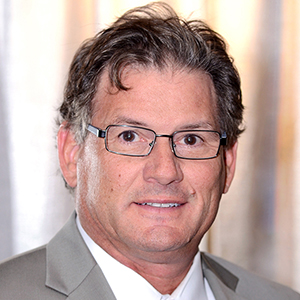 |
Dr. Barlow is my research mentor, who was assigned to me when I joined UNL. He also knows my Ph.D. advisor Dr. Holland and recruited me to join the Department of SECD at UNL in 2016. He has helped me tremendously starting from the hiring process to my first federal R21 award. | |
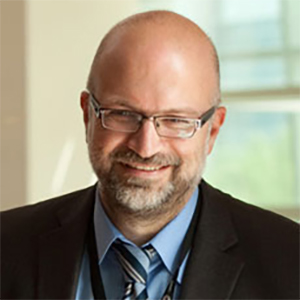 |
Dr. Stergiou is my research mentor who I contacted at the beginning of 2019. He is passionate about research and his words are always inspiring. Initially, I contacted him to be a consultant on my R21 grant. He not only gave me good advice on how to revise but also connected me with Dr. Zuniga, who became a good friend. He also agrees to be my research mentor without hesitation. Fortunately, I got my R21 funded without revision. I still thank him for being willing to help and taking time from his busy schedule to talk to me. | |
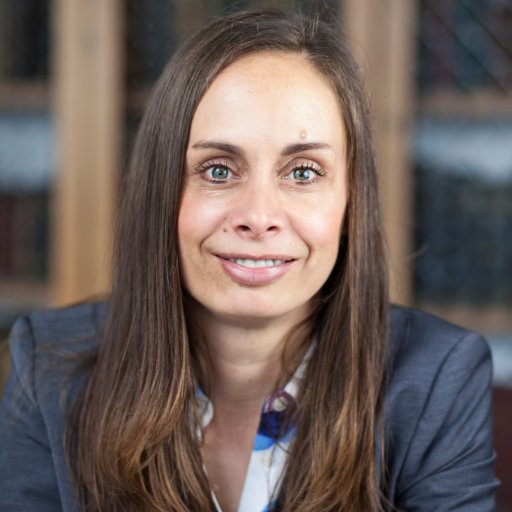 |
Dr. Gaab is my postdoctoral training mentor. I completed my two-year fellowship in her lab and expanded my research content area to reading. With my background in Biomedical Engineering, I had limited knowledge about reading difficulties. After a two-year fellowship with Dr. Gaab, I gained a great deal of foundational knowledge about the neural bases of reading development and insights about designing longitudinal studies with pre-kindergarteners. She is my role model for my academic career. I am always encouraged by her ability to manage multiple projects simultaneously and balance work and life as a mother of three young children. | |
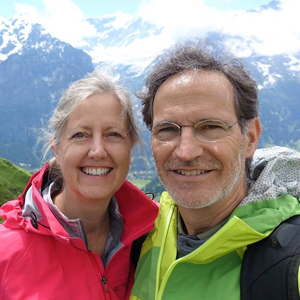 |
Drs. Scott K. Holland and Christy K. Holland both are my mentors. Scott was my primary advisor for my Ph.D. thesis. His insightful guidance and constructive advice tremendously helped me to shape my dissertation work. He is not only a pioneer in the field of pediatric neuroimaging but also a true builder who provides students with various opportunities to develop their professional skills and prepare them for their future careers. Christy reviewed my graduate school application and gave me the opportunity to pursue my Ph.D. in Biomedical Engineering in Fall 2009. She is also my role model for my academic career. Her high expectations motivated me to excel. During the preparation for my qualifying exam, I greatly benefited from her valuable and constructive suggestions which allowed me to improve my proposal and my oral presentation skills. Christy’s Seven Keys for a Successful Research Program: 1. Assemble a world-class group of students and faculty and leverage core strengths. 2. Establish a culture of mentorship and success. 3. Create programs and provide resources for student, fellow, and faculty development. 4. Promote interdisciplinary research and collaboration. 5. Diversify your funding portfolio to include governments, industry, philanthropy, and education, and commercialize discoveries. 6. Think creatively, embrace change, and advocate for research to advance patient care. 7. Encourage open-ended play in the laboratory. |
|
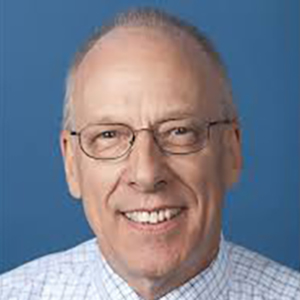 |
Dr. de Grauw was the department chair of Division of Neurology when I worked in the MEG lab. He is a visionary and supported my decision of pursuing Ph.D. when Dr. Xiang was opposed to my choice. Without his encouragement and supports, I would not be in the position today. I am still thankful for his advising. | |
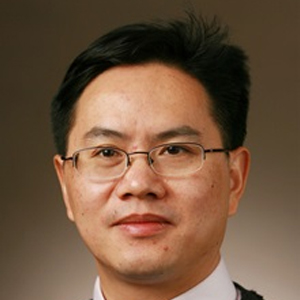 |
Dr. Xiang introduced me to Magnetoencephalography (MEG) and brought me into the field of functional neuroimaging in 2005, soon after we met when he visited my hometown of Shanghai. He offered me a one-year research opportunity to learn the MEG technique at SickKids hospital and then I would go back to Shanghai to establish a start-up imaging company. Toronto is where I dreamt of living when I was a child; I am not sure why. I was excited about this learning opportunity. My career path changed when Dr. Xiang was recruited to build the MEG center at Cincinnati Children’s Hospital. Our whole MEG lab moved from Toronto to Cincinnati. I was a little disappointed first because I had to leave my dream city. But if not for that transition, I would never be an Assistant Professor at UNL. As Steve Jobs once said, “You can’t connect the dots looking forward; you can only connect them looking backwards. So you have to trust that the dots will somehow connect in your future. You have to trust in something–your gut, destiny, life, karma, whatever”. Looking back, all the events happened in my life were somehow connected. |
Grants: Current
External:
Neural Predictors of Speech Perception Outcomes in Adults with Cochlear Implants
Early Career Award 1R21 DC018110, NIDCD, $460,380, 07/01/19-06/30/24. My role: PI. Due to COVID, the project had a slow start. Currently, it is on its second no-cost extension. I am preparing R01 application to deepen my research findings.
Internal:
Neural Predictors of Speech Perception Outcomes in Adults with Cochlear Implants: A Pilot Study
Great Plains IDeA-CTR Pilot Study, $50,000, 09/01/19-08/01/20. My role: PI.
Building the Infrastructure for Early Childhood Executive Function Research in Nebraska
Planning Grants, UNL, $20,000, 07/01/19-06/30/20. My role: Co-investigator (PI: Clark, C.)
Grants: Completed
External:
Brain imaging as measure of future cognitive outcomes in children
Bill & Melinda Gates Foundation, $1,267,354, 05/01/16-03/31/17. My role: I was the research consultant on data analysis. I was in charge of analyzing MRI structural, functional, and DTI data from Bangladesh MRI scans and providing statistical analyses for MRI data in relation to the variable of interest. (PI: Nelson, C., and co-PI: Gaab, N., Boston Children’s Hospital)
Neural Pre-markers of Dyslexia in Children Prior to Reading Onset: A Longitudinal fMRI Study
1R01 HD065762, $1,898,740, 03/15/11-03/31/16. My role: I was a postdoc fellow and in charge of analyzing functional, and DTI data. (PI: Gaab, N., Boston Children’s Hospital)
Developing Advanced MRI Methods for Detecting the Impact of Nutrients on Infant Brain Development
Abbott Fund, $1,811,464, 09/01/13-08/31/16. My role: I was a postdoc fellow and in charge of analyzing functional MRI and DTI data. (PI: Grant, E., co-PI: Nadine, G., Boston Children’s Hospital)
FMRI of normal language development in children
1R01 HD038578, $534,823, 07/01/09-06/30/12. My role: I was a doctoral student and in charge of data collection and analysis. (PI: Holland, S.K., Cincinnati Children’s Hospital)
Internal:
Identifying reading networks in the brain of typically developing children and hearing-impaired children
Great Plains IDeA-CTR Voucher program, $6,000, 03/01/19-06/30/19. My role: PI.
Identifying Neural and Behavioral Characteristics of Reading in Children with Hearing Loss
Layman Seed Award, UNL, $10,000, 05/01/18-04/30/19. My role: PI.
Peer-Reviewed Publications (in reverse chronological order)
Google Scholar Statistics as of May 23, 2020: total: 895; h-index: 20, i10-index: 29
* indicates the first author is a trainee (postdoc fellow, graduate, or undergraduate student) in the lab. The PI is usually the last author and corresponding author. This is the common practice in the field of cognitive neuroscience.
2020
- Wang, Y., Sibaii, F., Custead, R., Oh, H., & Barlow, S. M. (2020). Functional Connectivity Evoked by Orofacial Tactile Perception of Velocity. Frontiers in Neuroscience, 14, 182, DOI: 10.3389/fnins.2020.00182, [PDF], Journal Impact Factor (JIF): 3.65
- * Mathur, A., Schultz, D., Wang, Y. (2020). Neural bases of phonological and semantic processing in early childhood. Brain Connectivity [Epub Ahead of Print], DOI: 10.1089/brain.2019.0728, [PDF], JIF: 3.82
- Zuk, J., Dunstan, J., Norton, E., Yu, X., Ozernov-Palchik, O., Wang, Y., … Gaab, N., (2020). Multifactorial pathways facilitate resilience among kindergarteners at risk for dyslexia: A longitudinal behavioral and neuroimaging study. Developmental Science, 00:e12983, DOI: 10.1111/desc.12983, [PDF], JIF: 4.08
2019
- Turesky, T. K., Jensen, S. K., Yu, X., Kumar, S., Wang, Y., Sliva, D. D., … & Haque, R. (2019). The relationship between biological and psychosocial risk factors and resting‐state functional connectivity in 2‐month‐old Bangladeshi infants: A feasibility and pilot study. Developmental Science, 22(5), e12841, DOI: 10.1111/desc.12841, [PDF], JIF: 4.08
- Ozernov‐Palchik, O., Norton, E. S., Wang, Y., Beach, S. D., Zuk, J., Wolf, M., … & Gaab, N. (2019). The relationship between socioeconomic status and white matter microstructure in pre‐reading children: A longitudinal investigation. Human brain mapping, 40(3), 741-754., DOI: 10.1002/hbm.24407, [PDF], JIF: 4.55
2017
- Wang, Y., Mauer, M. V., Raney, T., Peysakhovich, B., Becker, B. L., Sliva, D. D., & Gaab, N. (2017). Development of tract-specific white matter pathways during early reading development in at-risk children and typical controls. Cerebral Cortex, 27(4), 2469-2485, DOI: 10.1093/cercor/bhw095, [PDF], JIF: 6.31
- * Custead, R., Oh, H., Wang, Y., & Barlow, S. (2017). Brain encoding of saltatory velocity through a pulsed pneumotactile array in the lower face. Brain Research, 1677, 58-73, DOI: 10.1016/j.brainres.2017.09.025, [PDF], JIF: 3.13
- * Oh, H., Custead, R., Wang, Y., & Barlow, S. (2017). Neural encoding of saltatory pneumotactile velocity in human glabrous hand. PLoS One, 12(8), e0183532, DOI: 10.1371/journal.pone.0183532, [PDF], JIF: 2.78
- Raschle, N. M., Becker, B. L. C., Smith, S., Fehlbaum, L. V., Wang, Y., & Gaab, N. (2017). Investigating the influences of language delay and/or familial risk for dyslexia on brain structure in 5-year-olds. Cerebral Cortex, 27(1), 764-776, DOI: 10.1093/cercor/bhv267, [PDF], JIF: 6.31
2016
- * Powers, S. J., Wang, Y., Beach, S. D., Sideridis, G. D., & Gaab, N. (2016). Examining the relationship between home literacy environment and neural correlates of phonological processing in beginning readers with and without a familial risk for dyslexia: an fMRI study. Annals of dyslexia, 66(3), 337-360, DOI: 10.1007/s11881-016-0134-2, [PDF], JIF: 2.17, First two authors have equal contributions and own co-first authorship.
- * Ozernov-Palchik, O., Yu, X., Wang, Y., & Gaab, N. (2016). Lessons to be learned: How a comprehensive neurobiological framework of atypical reading development can inform educational practice. Current opinion in behavioral sciences, 10, 45-58, DOI: 10.1016/j.cobeha.2016.05.006, [PDF], JIF: 3.42
2015
- Ji, L., Wang, Y., Zhu, D., Liu, W., & Shi, J. (2015). White matter differences between multiple system atrophy (parkinsonian type) and Parkinson’s disease: a diffusion tensor image study. Neuroscience, 305, 109-116, DOI: 10.1016/j.neuroscience.2015.07.060, [PDF], JIF: 3.24
- Thompson, E. A., Xiang, J., & Wang, Y. (2015). Frequency-spatial beamformer for MEG source localization. Biomedical Signal Processing and Control, 18, 263-273, DOI: 10.1016/j.bspc.2015.01.004, [PDF], JIF: 2.94
- Horowitz-Kraus, T., DiFrancesco, M., Kay, B., Wang, Y., & Holland, S. K. (2015). Increased resting-state functional connectivity of visual-and cognitive-control brain networks after training in children with reading difficulties. NeuroImage: Clinical, 8, 619-630, DOI: 10.1016/j.nicl.2015.06.010, [PDF], JIF: 3.94
2014
- Wang, Y., & Holland, S. K. (2014). Comparison of functional network connectivity for passive-listening and active-response narrative comprehension in adolescents. Brain Connectivity, 4(4), 273-285., DOI: 10.1089/brain.2013.0190, [PDF], JIF: 3.82
- Horowitz-Kraus, T., Wang, Y., Plante, E., & Holland, S. K. (2014). Involvement of the right hemisphere in reading comprehension: a DTI study. Brain Research, 1582, 34-44, DOI: 10.1016/j.brainres.2014.05.034, [PDF], JIF: 3.13,
- Szaflarski, J., Wang, Y., Altaye, M., Rajagopal, A., Byars, A., Plante, E., & Holland, S. (2014). Ten Years In The Making-A Longitudinal Study Of Language Development In Children And Adolescents (P3. 337), Neurology, 82 (1o Supplement), P3.337, Link, [PDF], JIF: 8.06
- Horowitz‐Kraus, T., Vannest, J. J., Kadis, D., Cicchino, N., Wang, Y., & Holland, S. K. (2014). Reading acceleration training changes brain circuitry in children with reading difficulties. Brain and Behavior, 4(6), 886-902, DOI: 10.1002/brb3.281, [PDF], JIF: 2.22
2008 – 2013
- * Gummadavelli, A., Wang, Y., Guo, X., Pardos, M., Chu, H., Liu, Y., … & Xiang, J. (2013). Spatiotemporal and frequency signatures of word recognition in the developing brain: a magnetoencephalographic study. Brain Research, 1498, 20-32., DOI: 10.1016/j.brainres.2013.01.001, [PDF], JIF: 3.13
- Korostenskaja, M., Harris, E., Giovanetti, C., Horn, P., Wang, Y., Rose, D., … & Xiang, J. (2013). Magnetoencephalography reveals altered auditory information processing in youth with obsessive-compulsive disorder. Psychiatry Research: Neuroimaging, 212(2), 132-140, DOI: 10.1016/j.pscychresns.2012.11.011, [PDF], JIF: 2.96
- Wang, Y., Adamson, C., Yuan, W., Altaye, M., Rajagopal, A., Byars, A. W., & Holland, S. K. (2012). Sex differences in white matter development during adolescence: a DTI study. Brain Research, 1478, 1-15, DOI: 10.1016/j.brainres.2012.08.038, [PDF], JIF: 3.13
- Wang, Y., Holland, S. K., & Vannest, J. (2012). Concordance of MEG and fMRI patterns in adolescents during verb generation. Brain Research, 1447, 79-90, DOI: 10.1016/j.brainres.2012.02.001, [PDF], JIF: 3.13
- Guo, X., Xiang, J., Wang, Y., O’Brien, H., Kabbouche, M., Horn, P., … & Hershey, A. D. (2012). Aberrant neuromagnetic activation in the motor cortex in children with acute migraine: a magnetoencephalography study. PLoS One, 7(11), DOI: 10.1371/journal.pone.0050095, [PDF], JIF: 2.78
- Guo, X., Xiang, J., Mun-Bryce, S., Bryce, M., Huang, S., Huo, X., Wang, Y., Rose, D., Degrauw, T., Gartner, K. and Song, T. (2012). Aberrant high-gamma oscillations in the somatosensory cortex of children with cerebral palsy: a meg study. Brain and Development, 34(7), pp.576-583., DOI: 10.1016/j.braindev.2011.09.012, [PDF], JIF: 1.76
- Wang, Y., Xiang, J., Vannest, J., Holroyd, T., Narmoneva, D., Horn, P., … & Holland, S. (2011). Neuromagnetic measures of word processing in bilinguals and monolinguals. Clinical Neurophysiology, 122(9), 1706-1717, DOI: 10.1016/j.clinph.2011.02.008, [PDF], JIF: 3.61
- Zhang, R., Wu, T., Wang, Y., Liu, H., Zou, Y., Liu, W., … & Fu, Z. (2011). Interictal magnetoencephalographic findings related with surgical outcomes in lesional and nonlesional neocortical epilepsy. Seizure, 20(9), 692-700, DOI: 10.1016/j.seizure.2011.06.021, [PDF], JIF: 2.06
- Huo, X., Wang, Y., Kotecha, R., Kirtman, E. G., Fujiwara, H., Hemasilpin, N., … & Xiang, J. (2011). High gamma oscillations of sensorimotor cortex during unilateral movement in the developing brain: a MEG study. Brain Topography, 23(4), 375-384, DOI: 10.1007/s10548-010-0151-0, [PDF], JIF: 2.19
- Korostenskaja, M., Pardos, M., Kujala, T., Rose, D.F., Brown, D., Horn, P., Wang, Y., Fujiwara, H., Xiang, J., Kabbouche, M.A. and Powers, S.W. (2011). Impaired auditory information processing during acute migraine: a magnetoencephalography study. International Journal of Neuroscience, 121(7), 355-365, DOI: 10.3109/00207454.2011.560312, [PDF], JIF: 1.85
- Xiang, J., Wang, Y., Chen, Y., Liu, Y., Kotecha, R., Huo, X., … & Mangano, F. T. (2010). Noninvasive localization of epileptogenic zones with ictal high-frequency neuromagnetic signals: Case report. Journal of Neurosurgery: Pediatrics, 5(1), 113-122, DOI: 10.3171/2009.8.peds09345, [PDF], JIF: 2.17
- Wang, X., Xiang, J., Wang, Y., Pardos, M., Meng, L., Huo, X., … & Hershey, A. D. (2010). Identification of abnormal neuromagnetic signatures in the motor cortex of adolescent migraine. Headache: The Journal of Head and Face Pain, 50(6), 1005-1016, DOI: 10.1111/j.1526-4610.2010.01674.x, [PDF], JIF: 1.28
- Huo, X., Xiang, J., Wang, Y., Kirtman, E. G., Kotecha, R., Fujiwara, H., … & Degrauw, T. (2010). Gamma oscillations in the primary motor cortex studied with MEG. Brain and Development, 32(8), 619-624, DOI: 10.1016/j.braindev.2009.09.021, [PDF], JIF: 1.76
- Chen, Y., Xiang, J., Kirtman, E. G., Wang, Y., Kotecha, R., & Liu, Y. (2010). Neuromagnetic biomarkers of visuocortical development in healthy children. Clinical Neurophysiology, 121(9), 1555-1562, DOI: 10.1016/j.clinph.2010.03.029, [PDF], JIF: 3.61
- Korostenskaja, M., Pardos, M., Fujiwara, H., Kujala, T., Horn, P., Rose, D., Byars, A., Brown, D., Seo, J.H., Wang, Y. and Vannest, J., (2010). Neuromagnetic evidence of impaired cortical auditory processing in pediatric intractable epilepsy. Epilepsy Research, 92(1), 63-73, DOI: 10.1016/j.eplepsyres.2010.08.008, [PDF], JIF: 2.18
- Xiang, J., Liu, Y., Wang, Y., Kotecha, R., Kirtman, E. G., Chen, Y., … & Rose, D. (2009). Neuromagnetic correlates of developmental changes in endogenous high-frequency brain oscillations in children: a wavelet-based beamformer study. Brain Research, 1274, 28-39, DOI: 10.1016/j.brainres.2009.03.068, [PDF], JIF: 3.13
- Xiang, J., Liu, Y., Wang, Y., Kirtman, E. G., Kotecha, R., Chen, Y., … & Mangano, F. T. (2009). Frequency and spatial characteristics of high-frequency neuromagnetic signals in childhood epilepsy. Epileptic Disorders, 11(2), 113-125, DOI: 10.1684/epd.2009.0253, [PDF], JIF: 2.05
- Kotecha, R., Xiang, J., Wang, Y., Huo, X., Hemasilpin, N., Fujiwara, H., … & deGrauw, T. (2009). Time, frequency and volumetric differences of high-frequency neuromagnetic oscillation between left and right somatosensory cortices. International Journal of Psychophysiology, 72(2), 102-110, DOI: 10.1016/j.ijpsycho.2008.10.009, [PDF], JIF: 2.88
- Kotecha, R., Pardos, M., Wang, Y., Wu, T., Horn, P., Brown, D., … & Xiang, J. (2009). Modeling the developmental patterns of auditory evoked magnetic fields in children. PLoS One, 4(3) e4811, DOI: 10.1371/journal.pone.0004811, [PDF], JIF: 2.78
- Wang, Y., Xiang, J., Kotecha, R., Vannest, J., Liu, Y., Rose, D., … & Degrauw, T. (2008). Spatial and frequency differences of neuromagnetic activities between the perception of open-and closed-class words. Brain Topography, 21(2), 75-85, DOI: 10.1007/s10548-008-0060-7, [PDF], JIF: 2.19
- Liu, Y., Xiang, J., Wang, Y., Vannest, J. J., Byars, A. W., & Rose, D. F. (2008). Spatial and frequency differences of neuromagnetic activities in processing concrete and abstract words. Brain Topography, 20(3), 123-129, DOI: 10.1007/s10548-007-0038-x, [PDF], JIF: 2.19
Publications in Chinese (in reverse chronological order)
The following manuscripts were written in Chinese with English abstracts.
2003 – 2005
- Wang, Y., Zhang, W. (2005). Design of 3D Reconstruction DSA System on Personal Computer [基于PC的DSA三维重建系统设计]. Control & Automation [微计算机信息], 27, 105-107, [PDF], Published in Chinese.
- Wang, Y., Zhang, W. (2004). The Technology of Digital Subtraction Angiography [数字减影血管造影技术]. China Medical Devices Information [中国医疗器械信息], 20 (6), 1-4, [PDF], Published in Chinese.
- Wang, Y., (2003). Bionic technology for implant systems. Laboratory Material & Bio Technique, 6, 41-45, [PDF], Published in Chinese.
Peer-reviewed Publications in Review/Revision
- * Zhang, Z., Peng, P., Eickhoff, S., Lin, X., Zhang, D., Wang, Y., (2020) Neural Substrates of the Construct, Development, and Material Domain in Executive Function: An ALE Meta-analysis. Developmental Review
Book Chapters
- Wang, Y. (2018). Emergent reading and brain development. In Early Childhood Education. IntechOpen, DOI: 10.5772/intechopen.82423, [PDF].
Conference Proceedings & Abstracts (in reverse chronological order)
- Turesky, T., Jensen, S., Kumar, S., Yu, X., Wang, Y., Zollei, L., Boyd, E., Sanfilippo, J., Sliva, D., Gagoski, B., Nelson, C., Gaab, N., (2017) Functional neural networks present in 2-month old Bangladeshi infants, but show no association with adversity, Developmental Science Special Issue, Abstract.
- Wang, Y., Xiang, J., Rose, D.F., Holroyd, T., Harris E., deGrauw, T.J., (2010) The Frequency Profile of Somatosensory Evoked Magnetic Fields in the Developing Brain, 17th International Conference on Biomagnetism Advances in Biomagnetism, IFMBE Proceedings, 28(9): 254-257.
- Thompson, E.A., Holland, S.K., Xiang, J., Wang, Y., (2010) MEG source localization using a frequency beamformer. Bioengineering Conference, Proceedings of the 2010 IEEE 36th Annual Northeast, 1-2.
- Guo, X., Xiang, J., Chen, Y., Meng, L., Wang, X., Wang, Y., (2010) Quantification of the Time and Frequency Signatures of Visual Cortical Activation in the Developing Brain: A Study with MEG and Wave-Cross Spectrogram, 17th International Conference on Biomagnetism Advances in Biomagnetism – Biomag2010, IFMBE Proceedings, 28(6): 183-186.
- Korostenskaja., M., Pardos, M., Lee, K.H., Fujiwara, H., Kujala, T., Xiang, J., Vannest, J., Wang, Y., et al., (2010) From Auditory Change Detection to Reading and Word Processing: Impairments in Children with Intractable Epilepsy. 17th International Conference on Biomagnetism Advances in Biomagnetism, IFMBE Proceedings, 28(13): 378-380.
- Xiang, J., Wang, Y., et al., (2007) Volumetric localization of epileptic activity using wavelet-based synthetic aperture magnetometry. Proceedings of the 15th International Conference on Biomagnetism, International Congress Series, 1300:697-700.
- Xiang, J., Xiao, Z., Wang, Y., et al., (2007) Detection of subtle structural abnormality in tuberous sclerosis using MEG guided post-image processing. Proceedings of the 15th International Conference on Biomagnetism, International Congress Series, 1300:693-696.
Presentations
Invited Talks (in reverse chronological order):
- Brain encoding of saltatory velocity through a pulsed pneumotactile array in the lower face, University of Cincinnati, Department of Biomedical Engineering, Graduate Seminar, Cincinnati, OH., November 2019.
- Functional Connectivity Evoked by Orofacial Tactile Perception of Velocity, University of Nebraska–Omaha, Department of Biomechanics and Center for Research in Human Movement Variability, Omaha, NE., October 2019.
- Bridge Education And Neuroscience, Walker School of Education, Midland University, Fremont, NE., October 2019.
- Research Updates, Nebraska Speech Language Hearing Association Fall Convention, Omaha, NE., October 2019.
- Functional Connectivity Evoked by Orofacial Tactile Perception of Velocity, 5th Annual SfN Satellite Event, Chicago, IL., October 2019.
- Understanding the Reading Brain, Nebraska Academy for Early Childhood Research Networking: Connecting with Community Research Partners, Lincoln, NE., May 2019.
- Understand the Reading Brain: An Insight from Deafness, Boys Town National Research Hospital, SMART lunch, Omaha, NE., April 2019.
- Brain connectivity changes in children with and without a familial risk for dyslexia during reading development, Center for Brain, Biology and Behavior (CB3), MRI Users’ meeting, Lincoln, NE., December 2016.
- White Matter Development in at-risk children and typical controls, University of Nebraska Medical Center, Department of Pharmaceutical Sciences–seminar, Omaha, NE., October 2016.
- Reading Development in Children, Department of Psychology, Cabin talk, Lincoln, NE., September 2016.
- White Matter Development in Children, CB3, MRI Users’ meeting, Lincoln, NE., April 2016.
- White Matter Development in at-risk children and typical controls, Children, Youth, Families and Schools (CYFS) Summit, Research in Early Childhood, Lincoln Marriott Cornhusker Hotel, Lincoln, NE., April 2016.
- White matter development in children at risk for dyslexia, Biomedical Engineering seminar series, University of Nebraska-Lincoln, Lincoln, NE., March 2016.
- Brain research on reading and language development, Department of Special Education and Communication Disorders, Brown bag talk, Lincoln, NE., February 2016.
- FMRI and MEG data fusion, Research Department of Biomedical Engineering in Institute of Electrical Engineering, Chinese Academy of Sciences (IEECAS), Beijing, China, June 2012.
- Integration of fMRI and MEG in language network, First MRI-71 conference, Cincinnati Children’s Hospital, OH., July 2011.
Oral and Poster Presentations (in reverse chronological order):
- Wang Y., Mathur, A., White matter pathways supporting basic reading skills in young children, Cognitive Neuroscience Society (CNS) 2020 Virtual Conference, May 2020, Poster presentation.
- * Mathur, A., Schultz, D., Wang, Y., Specialization of phonological and semantic reading routes in early childhood, Great Plains IDeA-CTR Annual Meeting, Omaha, NE., October 2019, Poster presentation.
- Wang, Y., Sibaii, F., Custead, R., Oh, H., and Barlow, S.M., Functional connectivity evoked by saltatory pneumotactile stimuli on the glabrous hand, Organization of Human Brain Mapping (OHBM) 2019 conference, Rome, Italy, June 2019, Poster presentation.
- * Grybas, E.A., Nguyen, L., Trat Thai, T.T.K., Mathur, A., Wang, Y., White Matter Characteristics in Pre-Preaders, University of Nebraska–Lincoln, Spring Research Fair, Lincoln, NE., April 2019, Poster presentation.
- * Mathur, A., Sibaii, F., Wang, Y., Neural specialization of reading in young children, Cognitive Neuroscience Society (CNS), San Francisco, CA., March 2019, Poster presentation.
- * Munn, L., Watkins, E., Walters, N., Sibaii, F., Wang, Y., Brain connectivity related to executive function in children with and without a familial risk for dyslexia, University of Nebraska–Lincoln, Spring Research Fair, Lincoln, NE., April 2019, Poster presentation.
- Turesky, T., Jensen, S., Yu, X., Kumar, S., Wang, Y., Sliva, D., Borjan, G., Sanfilippo, J., Haque, R., Kakon, S. H., Islam, N., Petri, W. J., Nelson, C., Gaab, N., The 6th Annual Flux Congress, “The relationship between poverty and resting-state functional connectivity in 2-month old Bangladeshi infants,” Podium Conference Specialists, Berlin, Germany, Bangladesh. August 2018, Oral presentation.
- * Ozernov-Palchik, O., Norton, E., Wang, Y., Beach, S., Zuk, J., Wolf, M., Gabrieli, J., Gaab, N., The relationships among SES, white matter, and reading development: a longitudinal investigation from kindergarten to 2nd grade, Twenty-Fifth Annual Meeting Society for the Scientific Study of Reading (SSSR), July 2017, Oral presentation.
- * Ozernov-Palchik, O., Norton, E., Wang, Y., Beach, S., Zuk, J., Wolf, M., Gabrieli, J., Patel, A., Gaab, N., White matter integrity in kindergarten predicts rhythm performance in 2nd grade, The Neurosciences and Music – VI, Music, Sound and Health, Boston, MA., June 2017, Poster presentation.
- * Zuk, J., Becker, B., Perdue, M., Yu, X., Wang, Y., Chang, M., Raschle, N., Gaab, N., Neural correlates of phonological processing: disrupted in children with reading impairment and enhanced in children with musical training, The Neurosciences and Music – VI, Music, Sound and Health, Boston, MA., June 2017, Poster presentation.
- * Zuk, J., Dunstan, J., Norton, E., Ozernov-Palchik, O., Wang, Y., Gabrieli, J., Gaab, N., Investigating protective and compensatory mechanisms in kindergarteners at risk for reading impairment who subsequently develop typical reading skills, 29th APS Annual Convention, Boston, MA., May 2017, Poster presentation.
- Wang, Y., Neural substrates of the executive attention network in children at-risk for dyslexia and typical controls, The dyslexia foundation, extraordinary brain symposium XV, The Buccaneer Hotel, St. Croix, US Virgin Islands. June 2016, Oral presentation.
- Wang, Y., Mauer, M. Raney, T., Peysakhovich, B., Becker, B., Sliva, D., Gaab, N., Development of tract-specific white matter pathways during early reading development in children at familial risk for dyslexia, Cognitive Neuroscience Society Annual Meeting, New York, NY., April 2016, Poster presentation.
- Wang, Y., Tract-specific white matter pathways during early reading development, Laboratories of Cognitive Neuroscience monthly meeting, Boston Children’s Hospital, Boston, MA., November 2015, Oral presentation.
- Wang, Y., Mauer, M., Raney, T., Peysakhovich, B., Becker, B., Sliva, D., Gaab, N. White matter development in children at risk for dyslexia, The Neurodevelopmental Disorders Symposium, Boston, MA., October 2015, Poster presentation.
- Wang, Y., Raschle, N.M., Sliva, D., Mauer, M., Powers, S., Becker, B., Peysakhovich, B., Gaab, N., Atypical development of executive function in pre-readers at familial risk for dyslexia: a longitudinal fMRI study, 2nd annual meeting for New England Research on Dyslexia (NERDY) Society, Boston, MA., October 2014, Poster presentation.
- * Sliva, D., Peysakhovich, B., Wang, Y., Grant, P.E., Gaab, N., Dehaes, M., Resting state auditory network strength is related to age, brain structure and familial risk for developmental dyslexia in infants, 4th Biennial Conference on Resting State Brain Connectivity, Cambridge, MA., September 2014, Poster presentation.
- Wang, Y., Atypical development of executive function in pre-readers at familial risk for dyslexia: a longitudinal fMRI study, Laboratories of Cognitive Neuroscience monthly meeting, Boston Children’s Hospital, Boston, MA., July 2014, Oral presentation.
- * Zuk, J., Wang, Y., Raschle, N.M., Becker, B., Chang, M., Gaab, N., Examining the neural correlates of rapid auditory processing and phonological processing in children with musical training, The 5th Annual Meeting of The Neurosciences and Music, Dijon, France, May 2014, Poster presentation.
- Wang, Y., Raschle, N.M., Sliva, D., Dauvermann, M.R., Becker, B., Ozranov-Palchik, O., Peysakhovich, B., Smith, S.A., Figuccio, M., Zuk, J., Gaab, N., The development of phonological processing from the pre-reading to the beginning-reading stage in children with and without a familial risk for developmental dyslexia, The 21st Annual Cognitive Neuroscience Society Annual Meeting, Boston, MA., April 2014, Poster presentation.
- Wang, Y., Integration of fMRI and MEG towards modeling language networks in the brain, Fetal-Neonatal Neuroimaging & Developmental Science Center weekly meeting, Boston Children’s Hospital, Boston, MA., March 2014, Oral presentation.
- Wang, Y., Holland, S.K., Vannest, J., Concordance of MEG and fMRI Patterns in Adolescents during Verb Generation, Human Brain Mapping conference, Beijing, China, June 2012, Poster presentation.
- Holland, S.K., Wang, Y., et al., Sex difference of white matter anisotropic diffusion in developing adolescent brain, Human Brain Mapping conference, Beijing, China, June 2012, Poster presentation.
- Wang, Y., Preliminary MEG/fMRI Data I/II, MEG Users’ Meeting, Cincinnati Children’s Hospital, Cincinnati, OH., August and September 2009, Oral presentation.
- Wang, Y., Focus on the brain – Human Brain Mapping 2009 conference summary, MEG Users’ Meeting, Cincinnati Children’s Hospital, Cincinnati, OH., July 2009, Oral presentation.
- Wang, Y., Xiang, J., et al., Neuromagnetic measures of word processing in bilinguals and monolinguals, Human Brain Mapping conference, San Francisco, CA., June 2009, Poster presentation.
Outreach Activities (in reverse chronological order):
- Neural Pathways Supporting Reading Development in Children Who Are Deaf/Hard Of Hearing, University of Nebraska–Omaha, The Deafness, Cognition and Language Research Centre, University College London, London, U.K., June 2019, Oral Presentation.
- Neural Plasticity in Individuals Who Receive Cochlear Implant (s), Nottingham Biomedical Research Centre, National Institute for Health Research, Nottingham, U.K., June 2019, Oral Presentation.
- Science After Dark – About the Brain, Archie’s Late Night Party, University of Nebraska State Museum, Lincoln, NE., June 2019, Interactive format with hands-on activities.
- Understanding the Reading Brain – advocating Brain Research for children who are deaf/hard of hearing, Library Event, Southeast Nebraska Regional Program for Students Who are Deaf or Hard of Hearing, May 2019, Oral Presentation.
Teaching Philosophy
My philosophy of teaching is to empower students with the knowledge and drive to face life’s challenges. As an educator, I believe my teaching goal is not only to deliver knowledge to students, but also to teach them how to learn which has a lifelong impact. As a researcher, I also believe that my role of teaching is to inspire future scientists through sharing my enthusiasm for my research projects. My teaching strategies reflect my teaching philosophy. My teaching philosophy is based on what I experienced at this point in my academic career. To me, teaching is also a learning experience and teaching philosophy should be dynamic. I will continue to improve my teaching strategies and methodology as I teach more. I believe each student has his/her own traits, and I will adapt to each student to maximize his/her learning outcomes. I also want to quote Stephen’s philosophy on education:
Teaching Mentor
All my research mentors also taught me how to be a good educator. After joining UNL, Dr. Cress is my assigned teaching mentor who also drove me around the town during my second interview visit. I remembered that she was recovering from a surgical procedure on her elbow during my first visit to UNL. She still came to meet with me with her elbow in a plaster cast. Her energy and kindness left me with a deep impression of people at UNL. I enjoyed a friendly environment during my interview, which was one of the major factors that led me to the position.
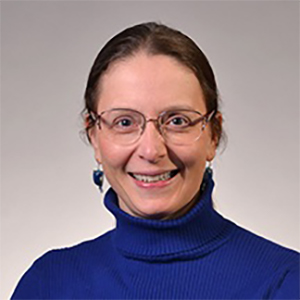 |
Dr. Cress is my teaching mentor assigned to me when I joined UNL. She is an excellent educator and has generously shared advice for both teaching and life. She also helped review my R21 grant and gave me valuable and constructive comments. She meets with me regularly to discuss my teaching strategies. She also observed my teaching during two of my courses in the Fall 2019 and gave me written advice. I am thankful to have someone like her as my teaching mentor. |
Courses
| SLPA 453 section 001 Neurological Foundations of Speech and Language
Department of Special Education & Communication Disorders, UNL Used backward design. You can download the benchmark course portfolio: https://digitalcommons.unl.edu/prtunl/207/ Download Previous Syllabus: 2021
|
Fall 2021 |
| SLPA 990 section 001 Neuroimaging & Language Disorders (Name has been changed–starting Fall 2020)
Department of Special Education & Communication Disorders, UNL Designed course syllabus, created and presented lectures on basic neuroimaging techniques, literature review on the use of neuroimaging in various communication and language disorders. Provided hands-on experience in neuroimaging data analyses. Download Previous Syllabus: 2016, 2017, 2018, 2019
|
Fall 2016 – 2019 |
| SLPA 990 section 002 Neural Basis of Reading (Name has been changed–starting Fall 2020)
Department of Special Education & Communication Disorders, UNL Designed course syllabus, created and presented lectures on reading development, neural bases of reading, and reading interventions. Download Previous Syllabus: 2017, 2018, 2019
|
Spring 2017, Fall 2018, 2019 |
| SLPA992/998 or BSEN 896 Independent Study
Department of Special Education & Communication Disorders & Department of Biological System Engineering, UNL Taught graduate students from both Speech-Language Pathology and Biomedical Engineering to learn about neuroimaging techniques. Provided hands-on experience for students to analyze various imaging data. Taught students how to run their own experimental studies. Taught students to practice critical thinking and form their own research questions. Download Previous Syllabus: 2017
|
Fall 2017 – 2019, Spring 2019, 2020, Summer 2017 – 2020, |
| SLPA 898 Directed Research/Research other than Thesis
Department of Special Education & Communication Disorders, UNL Direct speech-language pathology master student to do neuroimaging research. Taught her how to write IRB protocols and how to analyze neuroimaging data. Taught her how to generate final report to summarize research findings.
|
Fall 2017 – 2019 |
| Neuroimaging Data Analysis
Department of Special Education & Communication Disorders & Center for Brain, Biology and Behavior, UNL Designed course syllabus and created instructions on various neuroimaging data analysis techniques (MRI, fMRI, MEG, DTI). Provided sample data for students to practice and understand different neuroimaging data processing pipelines.
|
Summer 2017, 2018 |
| Neuroimaging course
Gaab Lab, Division of Developmental Medicine, Boston Children’s Hospital Designed course syllabus, created and presented 10 lectures on basic MRI principles, basic fMRI data analysis, and advanced neuroimaging data processing techniques. Designed and built the course website and provided trainees with hands-on materials.
|
Summer, Fall 2014 |
| Advanced Neuroimaging course
Cincinnati Children’s Hospital Organized the entire summer neuroimaging training course including inviting speakers and booking conference rooms. Prepared two lectures on advanced imaging methods including independent component analysis and connectivity analysis. Conducted two hands-on sessions and helped trainees with various analysis problems.
|
Summer, 2013 |
| Bioinstrumentation
Taught 10 four-hour laboratory lectures covering basic principles of biopotential electrodes, analysis and selection of physical, electrical, mechanical, and thermal transduction mechanisms for four quarters. Held weekly questions and answers sessions to provide additional help to students. Graded students’ laboratory reports, midterm, and final exams.
|
Winter, Spring 2009, Winter, Spring 2012 |
Student Mentoring (in reverse chronological order)
Postdoctoral Fellows
- Yinbo Wu, Ph.D., Psychology, University of Nebraska-Lincoln, 01/2021 – 08/16/2021 (Due to Visa Issue, J1 is still pending. She can’t work right now)
- Avantika Mathur, Ph.D., Neuroscience, National Brain Research Center, India, 03/2018 – 07/2020 (currently at Boys Town Research Hospital)
- Ying Chen, Ph.D., Industrial Engineering, University of Texas at Arlington, United States, 09/2017 – 12/2017
Graduate Students – Primary Advisor
- Soyoung Park, Ph.D. student in Speech-Language Pathology (SLP), Department of SECD, UNL, 01/2020 – Present.
- Fatima Sibaii, M.S. student in Biological Systems Engineering (BSE), Department of BSE, UNL, M.S. Thesis Title: “Real-Time Cerebrovascular Response during Pneumotactile Stimulation via Simultaneous fNIRS and fTCD,” 08/2017– Present.
- Caitlin Daly, M.S. student in SLP, Department of SECD, UNL, Thesis Title: “Neurological and Behavioral Effects of Melodic Intonation Therapy for Childhood Apraxia of Speech,” Dr. Judy Harvey serves as co-advisor and guides her clinical work, 01/2020 – 09/2021.
- Ceceli Bonitto, AuD. student, Audiology, Department of SECD, UNL, Capstone Project Title: “Neural Basis of Speech Perception in Adult Cochlear Implant Users,” 08/2018 – 05/2021.
- Bailey Heaton, AuD. student, Audiology, Department of SECD, UNL, Capstone Project Title: “Neural Basis of Speech Perception in Child Cochlear Implant Users,” 08/2018 – 05/2021.
- Vanessa Whattam, M.S. student in SLP, Department of SECD, UNL, Directed Research Title: “Study the reading brain,” 12/2017 – 05/2019.
- Poupack Baghery, M.S. student in Electric Engineering, Department of Computer and Electric Engineering, UNL, Independent Study Title: “Neuroimaging methods and their applications,” 01/2019 – 05/2019.
- Jacob L. Greenwood, Ph.D. student in BSE, Department of BSE, Independent Study Title: “Neuroimaging techniques,” 06/2017 – 08/2017.
- Mohsen Hozan, Ph.D. student in Biomedical Engineering, Department of BSE, Independent Study Title: “Neuroimaging techniques,” 06/2017 – 08/2017.
Graduate Students – Academic Committee Member
- Ross Westemeyer, Ph.D. in Human Science, Department of SECD, UNL, Primary mentor: Dr. Angela Dietsch, 08/2018 – Present.
- Jacob L. Greenwood, Ph.D. in BSE, Department of BSE, University of Nebraska-Lincoln, Thesis Title: “Multimodal assessment of somatosensory stimulation in acute cerebrovascular infarction,” Primary mentor: Dr. Steven M. Barlow, 05/2017 – Present.
- Claudia Cortes Reyes, M.S. in Biomechanics, Department of Biomechanics, University of Nebraska–Omaha, Thesis Title: “Assessment of Inter-limb Coordination in Prosthetic Users,” Primary mentor: Dr. Jorge Zuniga, 01/2019 – 05/2021.
- Christopher Copeland, M.S. in Biomechanics, Department of Biomechanics, University of Nebraska–Omaha, Thesis Title: “Effects of Gender in Novel Tool Use: Cortical and Functional Measures in Children using a Prosthetic Simulator”, Primary mentor: Dr. Jorge Zuniga, 01/2019 – 05/2021.
- Tamrat Teshome, Ph.D. in Human Science, Department of Child, Youth and Family Studies, UNL, Thesis Title: “Adverse Childhood Experiences And Adolescent Mental Health Problems,” Primary mentor: Dr. Jeong-Kyun Choi, 08/2018 – 08/2021.
- Sangeeta Nair, Ph.D. in Behavioral Neuroscience, Department of Psychology, University of Alabama at Birmingham, Thesis Title: “Combining MEG and fMRI to examine dynamic task-related brain activity with high spatiotemporal resolution,” Primary mentor: Dr. Jerzy P. Szaflarski, 02/2017 – 11/2021.
- Amirsalar Mansouri, Ph.D. in Electrical & Computer Engineering, College of Engineering, UNL, Primary Mentor: Dr. Khalid Sayood, 08/2014 – 12/2021.
- Elizabeth C. Hoffman, M.S. in SLP, Department of SECD, UNL, Thesis Title: “Vibrotactile Threshold Estimation in Neurotypical Children,” Primary mentor: Dr. Steven M. Barlow, Defended in 02/2020.
- Michaela K. Sullivan, M.S. in SLP, Department of SECD, UNL, Thesis Title: “Oral angle ramp-and-hold isomeric force dynamics in young neurotypical adults,” Primary mentor: Dr. Steven M. Barlow, 04/2018 Mid-review for thesis, Defended in 03/2019.
- Alajandra Marquez, “Non-nutritive Suck Pattern Stability in Extremely Premature Infants as a Function of Pulmonary Status,” M.S. in SLP, Department of SECD, UNL, Primary mentor: Dr. Steven M. Barlow, 04/2018 Mid-review for thesis.
- Lauren E. Wondra, M.S. in BSE, Department of BSE, UNL, Thesis Title: “Cerebral blood flow velocity hemodynamic values in critically ill infants under one year of age,” Primary mentor: Dr. Gregory R. Bashford, Defended in 11/2017.
- Hyuntaek Oh, D. in Biomedical Engineering, Department of BSE, UNL, Thesis Title: “Brain encoding of salutatory velocity-scaled somatosensory array in glabrous hand among neurotypical adults,” Primary mentor: Dr. Steven Barlow, Defended in 09/2016.
- Rebecca Custead, Ph.D. in Human Sciences, Department of SECD, UNL, Thesis Title: “Encoding of salutatory tactile velocity in the adult orofacial somatosensory system,” Primary mentor: Dr. Steven Barlow, Defended in 07/2016.
Undergraduate Students – Undergraduate Creative Arts and Research Experience (UCARE) in My Lab
- Marusha Ather, Department of BSE, UNL, Summer & Fall 2020, UCARE Team Project Title: “Brain Activity of Cochlear Implant Users,” UCARE Award: $4800
- Ann Pham, Department of Biochemistry, UNL, Fall 2020, UCARE Team Project Title: “Brain Activity of Cochlear Implant Users,” UCARE Award: $2400
- Patrick Wirball, Department of BSE, UNL, Fall 2020, UCARE Team Project Title: “Brain Activity of Cochlear Implant Users,” UCARE Award: $2400
- Makayla Gill, Department of Chemistry, UNL, Fall 2019, UCARE Team Project Title: “Understanding the Cochlear Implant,” UCARE Award: $2400
- Bergen Bruhn, Department of Psychology, UNL, Summer 2019, UCARE Team Project Title: “Understanding the Cochlear Implant,” UCARE Award: $2400
- Grace Carlson, Department of BSE, UNL, Summer 2019, UCARE Team Project Title: “Understanding the Cochlear Implant,” UCARE Award: $2400
- Grace Oh, Department of Biochemistry, UNL, Summer 2019, UCARE Team Project Title: “Understanding the Cochlear Implant,” UCARE Award: $2400
- Emily Grybas, Department of SECD, UNL, Fall 2018, UCARE Team Project Title: “Study the reading brain,” UCARE Award: $2400
- Linneaa Nguyen, Department of BSE, UNL, Fall 2018, UCARE Team Project Title: “Study the reading brain,” UCARE Award: $2400
- Thy Thy Trat Thai, Department of BSE, UNL, Fall 2018, UCARE Team Project Title: “Study the reading brain,” UCARE Award: $2400
- Nicole Walters, Department of Biology, UNL, Fall 2017, UCARE Team Project Title: “Brain Connectivity Changes in Children with and without a Familial Risk for Dyslexia During Reading Development,” UCARE Award: $2400
- Laura Munn, Department of SECD, UNL, Fall 2016, 2017, UCARE Team Project Titles: “Brain Connectivity Changes in Children with and without a Familial Risk for Dyslexia During Reading Development,” and “Executive function in children at-risk for reading impairment,” UCARE Award: $4800
- Ellie Watkins, Department of SECD, UNL, Fall 2016, 2017, UCARE Team Project Titles: “Brain Connectivity Changes in Children with and without a Familial Risk for Dyslexia During Reading Development,” and “Executive function in children at-risk for reading impairment,” UCARE Award: $4800
- Katie Monson, Department of SECD, UNL, Fall 2016, UCARE Team Project Title: “Executive function in children at-risk for reading impairment,” UCARE Award: $2400
Graduate and Undergraduate Student-Workers or Volunteers in My Lab
- Rebekah Urban, Graduate Student Worker, Administering standardized assessments, M.S. student in SLP, Department of SECD, UNL, 12/2020 – 11/2021.
- Hannah Gaffney, Graduate Student Worker, Administering standardized assessments, M.S. student in SLP, Department of SECD, UNL, 12/2020 – 11/2021.
- Elaine Williams, Graduate Student Worker, Administering standardized assessments, M.S. student in SLP, Department of SECD, UNL, 11/2019 – 11/2020.
- Taelor Williamson, Graduate Student Worker, Administering standardized assessments, M.S. student in SLP, Department of SECD, UNL, 11/2019 – 11/2020.
- Seyedeh Dorsa Motevalli, Undergraduate Student Volunteer, Assisting with data entry, transcription, and other clerical support, B.S. student in BSE, Department of BSE, UNL, 10/2019 – 05/2020.
- Kymberly Caddell, Graduate Student Worker, Administering standardized assessments, Ph.D. student in Education Psychology, Department of Educational Psychology, UNL, 05/2019 – 12/2019.
- Tamrat Teshome, Graduate Student Volunteer, Assisting with data entry, transcription, and learning neuroimaging techniques, Ph.D. student in Human Science, Department of Child, Youth and Family Studies, UNL, 04/2019 – 09/2019.
- Randa Ismail, Undergraduate Student Volunteer, Assisting with data entry, transcription, and other clerical support, B.S. student in Biochemistry, Department of Biochemistry, UNL, 04/2019 – 09/2019.
- Grace Oh, Undergraduate Student Volunteer, Assisting with data entry, transcription, and other clerical support, B.S. student in Biochemistry, Department of Biochemistry, UNL, 05/2018 – 05/2019.
- Molly Thornbrugh, Undergraduate Student Volunteer, Assisting with data entry, transcription, and other clerical support, B.S. student in Audiology, Department of SECD, UNL, 08/2018 – 11/2018.
- Cristal Franco-Granados, Undergraduate Student Worker, Assisting with recruitment, data entry, data collection, and other clerical support, B.S. student in Biology, Department of Biology, UNL, 05/2018 – 08/2018.
- Michelle Rohman, Undergraduate Student Worker, Assisting with recruitment, data entry, data collection, and other clerical support, B.S. student in BSE, Department of BSE, UNL, 05/2018 – 08/2018.
- Joelly Anderson, Undergraduate Student Worker, Assisting with recruitment, B.S. student in SLP, Department of SECD, UNL, 05/2018 – 08/2018.
- Nicole Walters, Undergraduate Student Volunteer, B.S. student in Biology, Department of Biology, UNL, 09/2016 – 2017.
- Sarah Hughes Berheim, Undergraduate Student Volunteer, B.S. in Psychology, Department of Psychology, UNL, 10/2017 – 05/2018.
- Sampashree Nayak, Graduate Student Volunteer, M.S. in Educational Psychology, Department of Educational Psychology, UNL, 04/2016 – 03/2017.
Professional and Discipline Related Services
Grant Review
- NSF Science of Learning Panel Reviewer
Conference Review
- Organization of Human Brain Mapping
Journal Review (in Alphabetical Order)
- Aging
- Brain and Behavior
- Brain and Cognition
- Brain Connectivity
- Brain Imaging and Behavior
- Brain Structure and Function
- Child Neurology Open
- Child Neuropsychology
- Cortex
- Current Eye Research
- Developmental Science
- Dyslexia
- Ear and Hearing
- Frontiers in Human Neuroscience | Brain Imaging and Stimulation
- Frontiers in Neuroscience | Brain Imaging Methods
- Human Brain Mapping
- IEEE Access
- Journal of Experimental Child Psychology
- Journal of Neurolinguistics
- Journal of Medical Imaging and Health Informatics
- Journal of the International Neuropsychological Society
- Language, Cognition and Neuroscience
- Network: Computation in Neural Systems
- Neuroimaging Clinical
- Neuropsychologia
- PLoS One
- Psychiatry Research: Neuroimaging
- Psychology & Neuroscience
- The Journal of Pediatrics
Extracurricular University and Community Services (in reverse chronological order)
|
01/2020 – Present |
|
12/2018 – Present |
|
08/2018 – Present |
|
10/2017 – Present |
|
01/2016 – Present |
|
03/2020 – 06/2020 |
|
01/2020 |
|
Fall 2019 |
|
07/2019 – 12/2019 |
|
09/2019 |
|
03/2019 |
|
Spring 2019 |
|
01/2019 |
|
07/2019 – 12/2018 |
|
4/11/2018 |
|
4/10/2018 |
|
12/2016 – 04/2017 |
|
4/4/2017 |
|
4/5/2017 |
|
4/8/2016 |
|
2011 – 2012 |
|
2010 – 2011 |
|
2006 – 2013 |
Professional Memberships
|
2019 – Present |
|
2019 – Present |
|
2019 – Present |
|
2017 – Present |
|
2015 – Present |
|
2014 – Present |
|
2014 – Present |
|
2010 – Present |
|
2010 – Present |
|
2007 – Present |
- Brain imaging brings predictors for cochlear implantation success into focus, Nebraska Today News, 12/02/2019
- Guest speaker, talking about cochlear implant with Dr. Miller, KROF (960 AM or 103.3 FM) radio talk show, Broadcasted on 09/14/2019, and 09/21/2019
- Brain Awareness: Wang brings brain imaging expertise to SECD, Department News, 03/20/2017
- Neural Bases of Reading and Clinical Implications, NSLHA’S 2020 Virtual Fall Convention, 09/18/2020
My Family
Without unconditional love and unwavering supports from my family, friends, co-workers, and others, I would not be in this position today. On this page, I would like to express my gratitude and thanks to them.
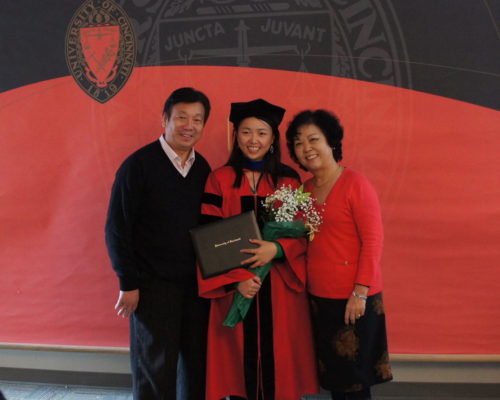 |
I want to thank my parents. They taught me that a college education is a necessity, not an option for me, when I was only in kindergarten. They always had high expectations for me and had faith that I would achieve those expectations. They are my driving force to reach high for my goals. Although we are over 7,000 miles apart, their constant encouragement and endless love filled my heart throughout my entire course of graduate study and continues to fill my heart every day. I am forever grateful to them and dedicate my Ph.D. dissertation to my loving parents. They are hard workers. Due to historical reasons, they were both sent to learn farming after graduating from middle school. My father worked as an electric welder in a chocolate factory and later became a chef. I remember that he always brought me treats when I was a little girl. I missed his cooking a lot after I came to North America. My mother worked as a tailor and later became a quality control manager for exporting clothing in a clothing factory. Although neither of them attended college, they always had high expectations for me. I am a first-generation college graduate in my family. | |
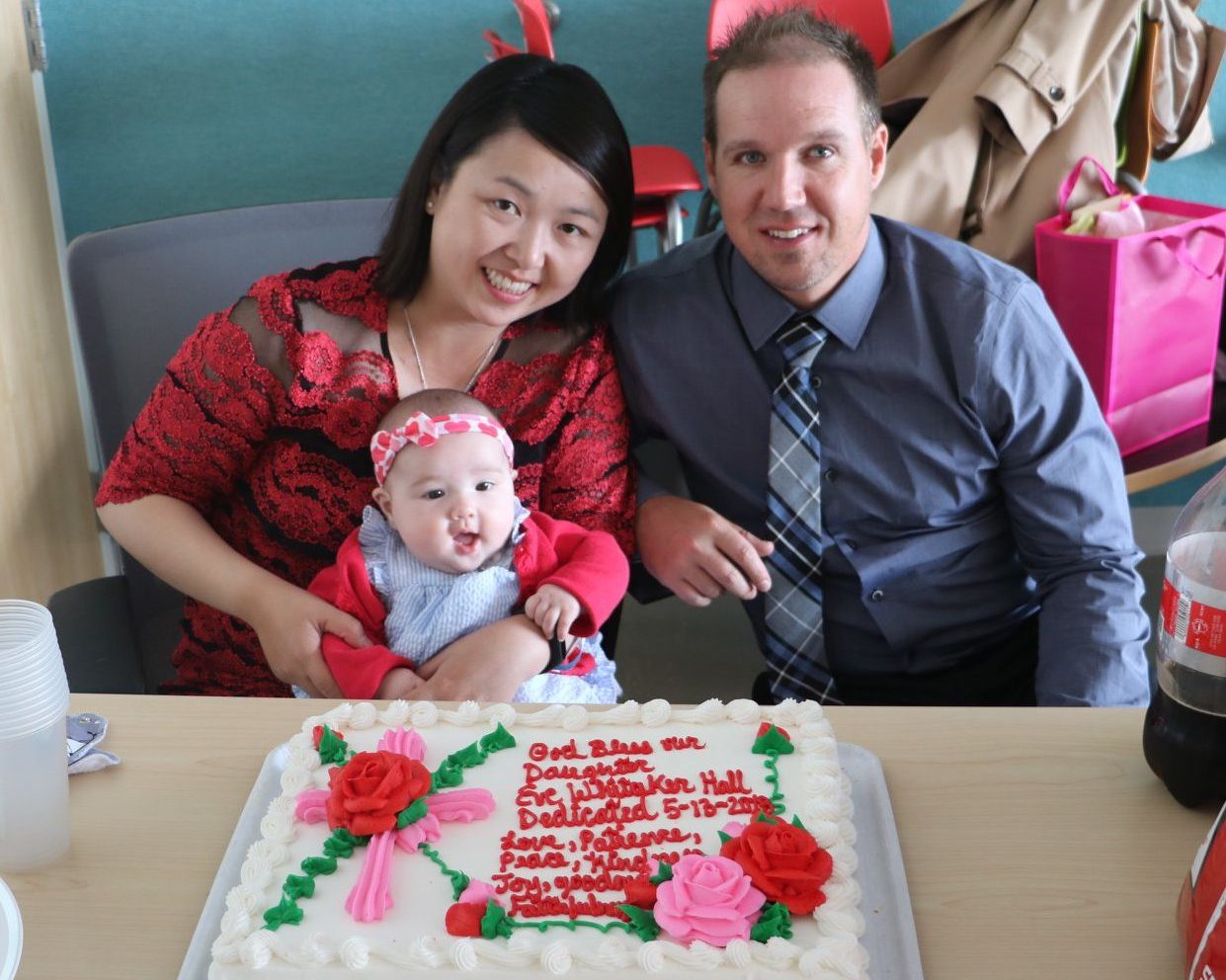 |
On January 2, 2017, I got married and had my daughter on January 5, 2018. We celebrated in Lincoln, in my hometown [Shanghai Wedding Video], and in my second hometown Cincinnati. I started my own family after being single for a long time. I cherish my husband and my daughter. They are my strong supporters. When I became a mother, I realized how much I need to learn to balance a demanding academic career and a life with a young child. I appreciate the tips from Nadine, who is my postdoctoral advisor and who also has three young children. I am incredibly thankful that my husband helped me a lot with chores and watching my daughter. Especially when we found out our daughter had a rare blood cancer called Chronic Eosinophilic Leukemia (CEL), which is a specific type of leukemia on August 22, 2019, he stayed strong as the leader of our family. That was the most challenging time in my life. As new parents, we were scared and stressed. But we had to be strong for her and tried our best to make our daughter feel loved and safe. Her illness also made me realize the importance of medical research. Without advancements in cancer research, her life quality would decrease dramatically. Right now, she takes 100mg imatinib per day, and her total counts of white blood cells went back to normal. We are thankful she is stable and responding well to this drug. Without medical research on new medications, her quality of life would be low, which motivated me to thrive in my research field to help other families.
Without my husband’s unconditional love and generous support, I don’t know if I could be as productive as I am now. |
|
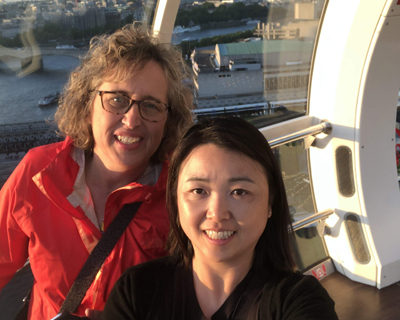 |
Tam is my sister in Christ. We met at a bible study group in 2006 and shared the same birth date. She is very special to me. She is like my family. Friends are gardeners of our souls. Her friendship is like a beautiful flower that has bloomed in my heart since 2006. We both love traveling, and have taken many trips together. During my toughest time, she was always there to help and support me. She has made Cincinnati my second hometown. I am forever thankful for her love and unwavering support. Some photos and videos from our trips: [Hong Kong], [Shanghai], [2010 Christmas] | |
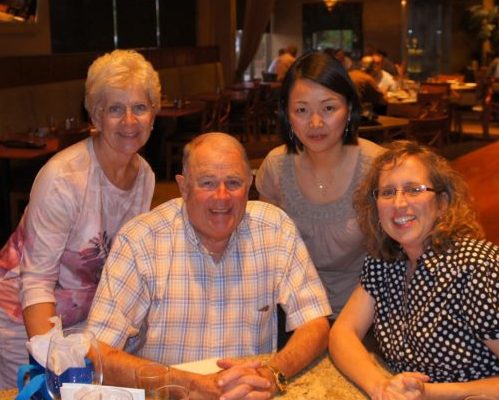 |
I met Tom and Carolyn at Hope church in September of 2006. They treated me like a daughter and said that I am their Chinese daughter. They introduced me to many American cultures and gave me many first experiences (i.e., buying my first used car, first pumpkin carving, first Italian food, etc.). They also made me feel Cincinnati is my second hometown. I always thought of them as my American parents. Tom was a successful businessman. He wrote a book called “mind your own (small) business,” and you can buy this book from Amazon. He was always helpful, loving, and devoted Christian. I wish God didn’t take this beautiful soul away from us so soon. He passed away on 9/16/2017 (76 years old) and was surrounded by his family and loved ones. His daughter told me that he went to heaven with peace. The last time I hugged and kissed him was at my third marriage celebration on August 22, 2017. He was laughing and stayed positive even he was not feeling very well at that time. What a special man he was! I still couldn’t believe he went to heaven. I miss his humor and smile very much. |
My Photo Gallery
My Friends
Wherever I go, I always met amazing people. Some of them are my co-workers, some of them are my brothers and sisters in Christ, and some of them are my classmates. Here I posted the group picture for each city where I lived in reverse chronological order.
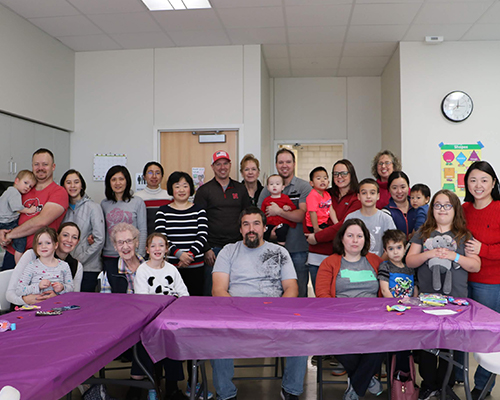 |
I moved to Lincoln, NE., United States, at the end of 2015, after I finished my two-year postdoctoral fellowship. UNL has lots of Chinese professors. The beginning of academic life can be demanding. We didn’t end up gathering often. I did have a group of closer friends who I met regularly. In the future, I want to be involved more in Lincoln’s Chinese Church. | |
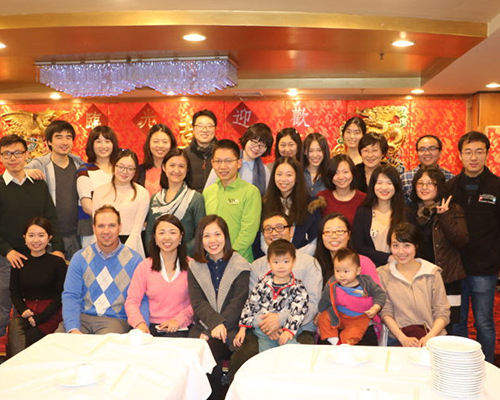 |
I moved to Boston from Cincinnati in late 2013 after I obtained my doctoral degree. The two-year time in Boston was memorable. I met many brothers and sisters in Christ at the MIT bible study group. They made two videos for me as farewell wishes [video #1] and [video #2]. Every time I experience difficulties, I like to watch those two videos over and over again. They always make me feel loved. Looking back, their wishes for me came true. Now I have my own family (a loving husband and a cute baby). I miss my friends in Boston, and I also miss the fresh seafood and various cuisine from Boston. Boston is one of the favorite cities I have visited. | |
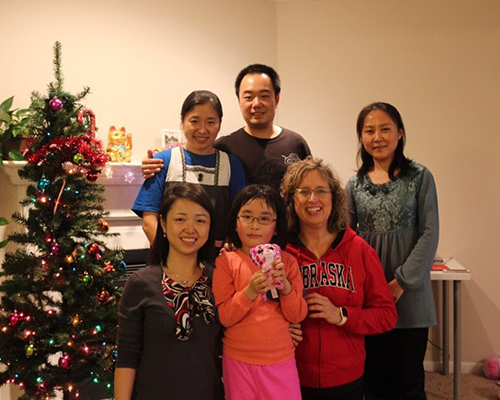 |
Cincinnati is my second hometown. I spent almost eight years there and made many great friends. I love the city because of the people there. Cincinnati became one of my favorites because my best friend and American “parents,” and many other friends are there. It has a relatively big Chinese population. I can find various Chinese cuisine in Cincinnati. | |
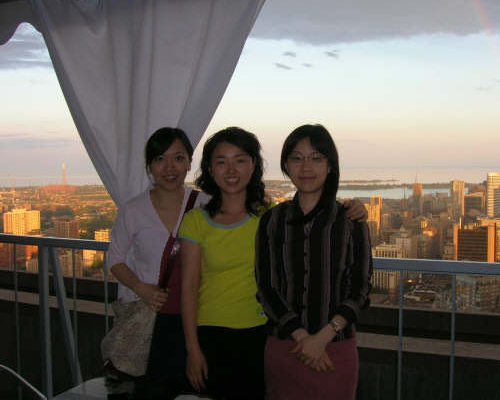 |
I stayed in Toronto only for a short period from November 2005 to June 2006. I still met a couple of good friends with whom I often went hiking. Toronto is my dream city. I not sure why. The city has a diverse population. I didn’t feel homesick when I was there. My English didn’t improve much because I can use Chinese almost everywhere (i.e., banks, stores, etc.), which made me feel welcomed. When I left Toronto for Cincinnati, Iris made a video for me. | |
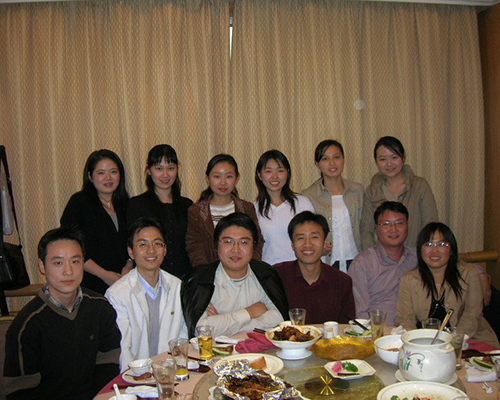 |
Shanghai is my hometown, and I was born and raised there. I lived there until 2005. I love Shanghai. But for some reason, I feel like that I don’t fit in. I left because of my childhood dream and my parents’ high expectations. I didn’t do well for my college entrance exam and didn’t get into my dream school (Fudan University). Therefore, before the first day of college, my parents told me that they expected me to do well and continue my education after college. I got scholarships every year and got into graduate school right after college. After graduate school, I chose to leave Shanghai. At the time, they were so proud of me. My big extended family (a van of 11 people) and my friends sent me to the airport and wished me best luck on Nov.11, 2005. However, nowadays, they regretted sending me abroad. |
My Hobbies
I started to run when I was in Boston. Running is the best way to relax my brain and make me happy. To date, I finished a full marathon and two half marathons. Besides running, I also enjoy going fishing with my husband and my dad. I learned to be patient and to have perseverance from fishing. I also love to travel to different places to learn about other cultures.
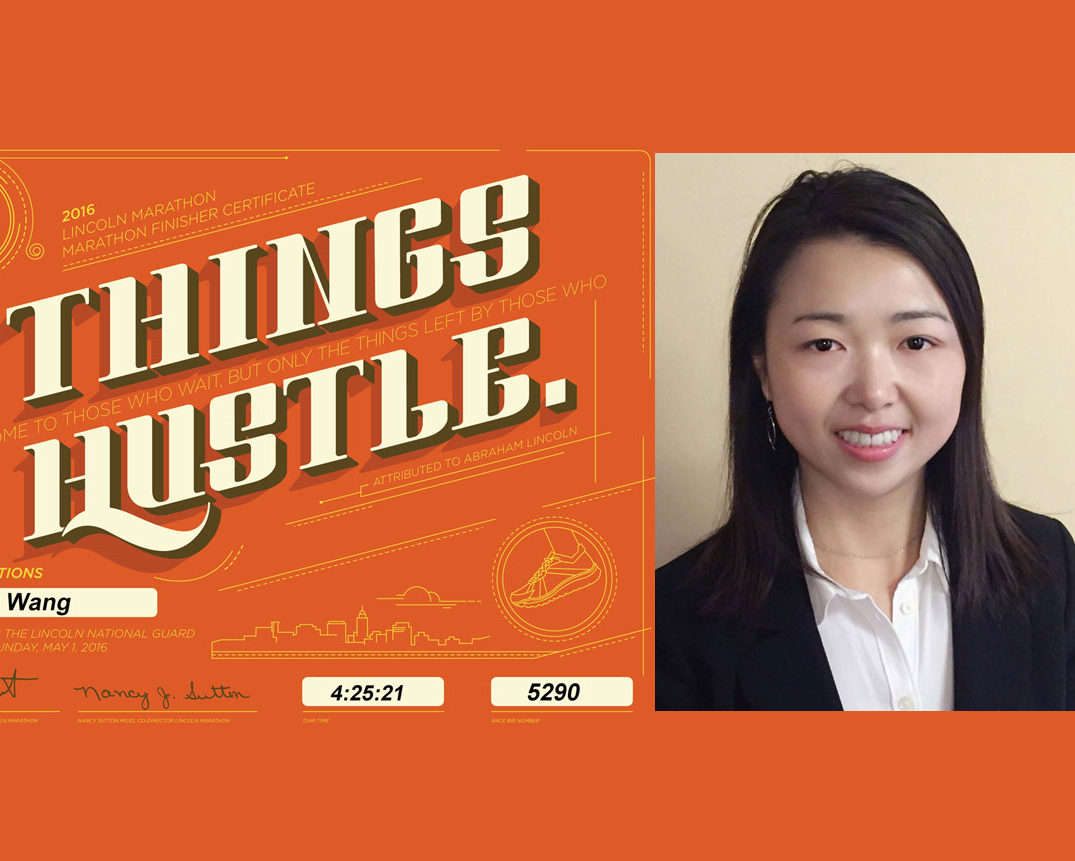 |
I trained over half a year and finished my first full marathon in 4 hours and 25 minutes. I’ve never thought of being a runner. Now I enjoyed running so much. | |
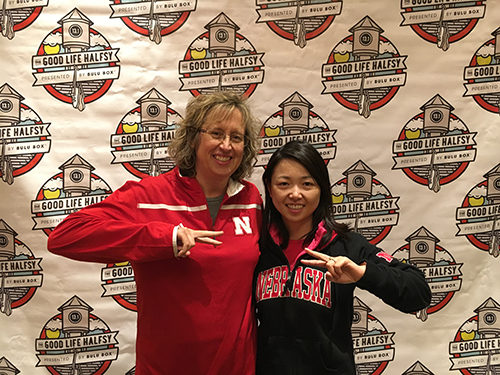 |
I encouraged my best friend to participate in our first half marathon in Lincoln, NE. We both completed our first half marathon. This is my first experience of running a half marathon. | |
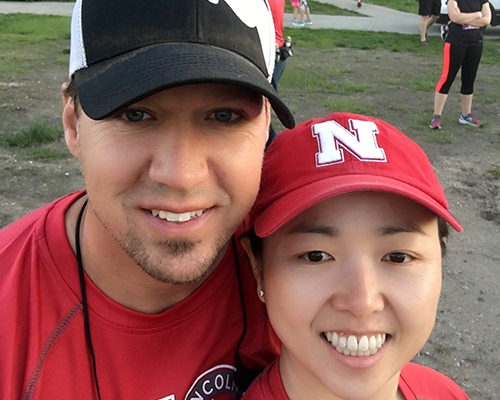 |
Right before this second marathon, I found out that I was pregnant. My husband and I ran and walked, and we completed our first half marathon together. This is my second half marathon. | |
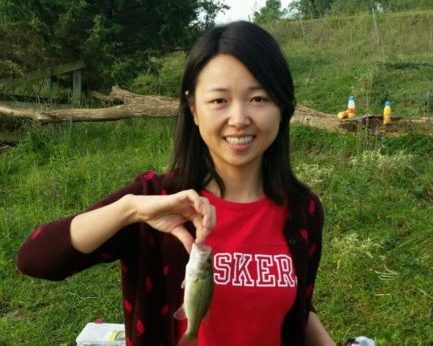 |
I love to go fishing with my dad when he visited us from China. Fishing is relaxing activity. My dad is the one who taught me how to use worms to catch fish. My husband is the one who taught me how to use casting skills to catch fish. One requires less work. You sit and wait after you put the worm on the hock and throw it into the lake. The other requires more work. You need to continually cast and wheel. I enjoyed both but preferred the casting style of fishing. |
